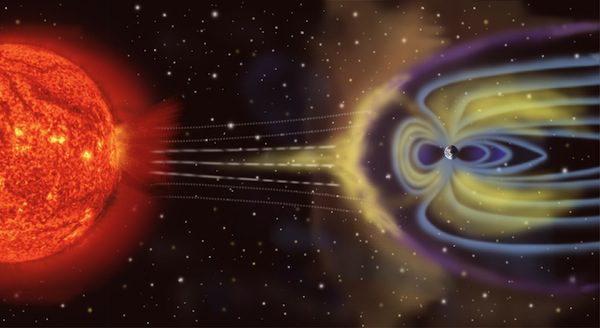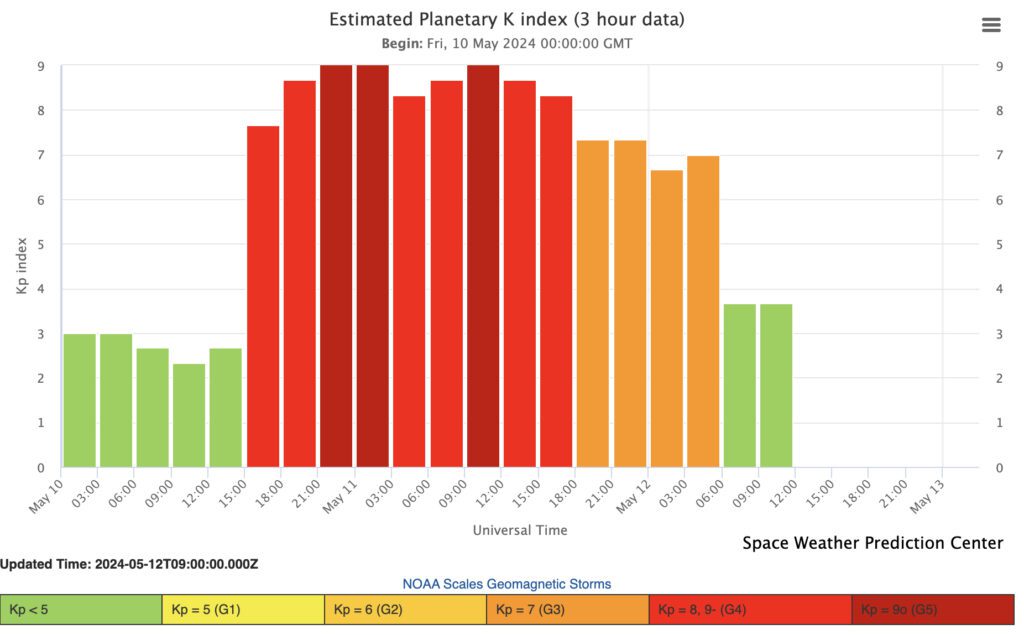Historic Solar Storm Spurs PJM to Extend Geomagnetic Disturbance Warning
Grid operator PJM Interconnection has issued a geomagnetic disturbance (GMD) warning after observing “persistent geomagnetically induced current (GIC) at multiple stations” late on Friday.
PJM initially issued a GMD warning on May 10 to generators and transmission operators that an ongoing severe solar storm could affect its system between 1:48 p.m. and 9 p.m. on Friday. The grid operator heightened the warning to an action after it observed irregularities on its system at 10:15 p.m. Friday. While the action was canceled at noon on Saturday, PJM extended the GMD warning through the end of Sunday, May 12.
PJM noted no major impacts to grid operations have been so far reported, nor does it anticipate “any significant impacts or emergency conditions at this time.” The grid operator says it is “monitoring GMD activity closely and is in close coordination with generation and transmission owners and neighboring grid operators.”

A Historic Solar Storm
The grid operator’s vigilance is heightened owing to the severity of the ongoing solar storm, which the National Oceanic and Atmospheric Administration (NOAA) has called “historic.”
NOAA measures the magnitude of geomagnetic storms using the K-index and, by extension, the Planetary K-index (Kp scale). Like hurricanes, tornadoes, and earthquakes, the scale conveys the severity of a geomagnetic storm event, with G5 being the most extreme and G1 being minor.
On Saturday night, NOAA said G3 to G4 conditions persisted through most of Saturday, with a G5 period occurring early in the day. G5 has the potential to cause “widespread voltage control problems and protective system problems can occur, some grid systems may experience complete collapse or blackouts. Transformers may experience damage.” G4 points to a “severe” storm that could prompt “possible widespread voltage control problems and some protective systems will mistakenly trip out key assets from the grid.”

NOAA said there have already been “preliminary reports of power grid irregularities, degradation to high-frequency communications, GPS, and possibly satellite navigation.” At 9 a.m. EST on Sunday, it warned the “ongoing geomagnetic storm will likely once again become more intense later today.”
NASA: Solar Activity Part of an Ongoing Cycle
NASA on April 28 suggested the heightened solar activity is part of an ongoing cycle—Solar Cycle 25—which commenced in 2019 and is projected to peak around 2024 or 2025. The national space agency says it has documented a remarkable intensification in solar activity. This phase is characterized by an unprecedented rise in sunspot counts, “the highest in over two decades,” with instances of up to “nine major solar flares” recorded in a single day, it said. The sharp escalation as the cycle approaches its peak is anticipated to be more intense than earlier forecasts had predicted, NASA warned.
That could have major implications for the power system, which has long been wary about the potential impact of GICs.
“GMD causes relatively low-frequency (much less than 1 Hz) changes in the earth’s magnetic field,” explained the Pacific Northwest National Laboratory in a recent report. “Interaction of a changing magnetic field with the deep earth conductivity induces an electric field at the earth’s surface, which in turn causes quasi-DC current [an ac waveform with a period of several minutes], known as GICs, to flow in long conductors with earth connections, such as the power grid,” it said.
PNNL notes two primary grid risks are associated with GIC: “(1) the potential for widespread damage to high-voltage transformers, and (2) the potential for voltage collapse due to GIC-induced reactive power losses. In particular, GICs can cause overheating and damage to the transformers, with high harmonic currents caused by the saturation of transformers. GICs can also cause relays, capacitive components such as [static VAR Compensators (SVCs)], and other protection devices to trip, thereby contributing to grid instability; this effect is compounded by the fact that transformers already absorb extra reactive power due to GICs.”
Industry Has Made Tremendous Progress to Address GICs
On March 10, 1989, a solar storm prompted a severe GMD event that produced two periods of intensity that registered K9. The storm induced DC ground current that saturated transformers and generated even-order harmonic currents that caused seven static compensators on the Hydro-Quebec’s 735-kV network to trip or shut down. That gave rise to system instability that culminated in the separation of 9.5 GW of generation from the adjacent La Grande generating stations and cascaded into a system collapse “within seconds,” according to a report from the North American Electric Reliability Corp. (NERC).
PNNL notes that over the last decade, “tremendous progress has been made by the electric power community in understanding the impact of GICs on the grid and in the development of tools to help with their modeling and mitigation.” The progress led to the creation of NERC Standard TPL-007-4, “Transmission System Planned Performance for Geomagnetic Disturbance Events,” which the Federal Energy Regulatory Commission approved in 2016.
PJM says that its warnings are part of a careful alignment with power participants. “To increase awareness of possible issues, PJM members have installed special equipment to detect and measure ground-induced currents,” it notes. “When a geomagnetic disturbance is forecast, PJM monitors these installed detectors at various locations. Should sustained ground currents at a certain level be detected, the PJM Manual for Emergency Operations details actions PJM and its members take in response.”
—Sonal Patel is a POWER senior editor (@sonalcpatel, @POWERmagazine).
Editor’s Note: This story is currently evolving and subject to change. We encourage you to revisit this article or check our website for the latest updates.